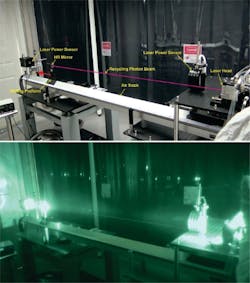Photonic Laser Thruster propulsion demonstrated in spacecraft simulation
Y.K. Bae Corporation announces their proprietary Photonic Laser Thruster (PLT) has successfully accelerated an approximately 1 pound spacecraft simulator with pure laser light. The project was funded by a Phase II grant of NASA Innovative Advanced Concepts (NIAC).
RELATED ARTICLE: Hybrid laser-ablation/gas-nozzle propulsion could propel rockets to orbit
Conducted in a Class 1000 cleanroom, Y.K. Bae's demonstration amplified photon power 400 times to achieve photon thrust up to 1.1 milliNewtons by bouncing photons several hundred times between two laser mirrors. The amplified thrust successfully propelled a gliding platform along a 2 m frictionless air track, simulating zero-gravity.
"Moving a 450 gram platform unequivocally validates the useful power-to-thrust ratio of PLT," said Claude Phipps, chair of the International High Power Laser Ablation and Directed Energy Symposium. "I can see future development that includes optical cavities that span many kilometers achieved with precise mirror alignment to enable maneuvering spacecraft many kilometers apart, and propellant-free propulsion of satellites in formations."
The PLT demonstration simulated beaming thrust between vehicles, which also included slowing and stopping the simulator. Benefits of a PLT spacecraft system include a dramatic reduction in fuel consumption in a wide range of space applications, such as orbit adjustments, drag compensation, and rendezvous and docking. The thrust-beaming capability of PLT further enables a distributed multivehicle approach, a revolutionary departure from the "all-in-one" single-spacecraft approach.
You can view the PLT simulation video below:
"PLT technology has the potential to revolutionize space mission designs," said Mason Peck, associate professor in Mechanical & Aerospace Engineering at Cornell University, who has also served as NASA's chief technologist. "Fully developed PLT could serve current commercial and non-commercial needs by increasing the life of LEO satellites, and therefore reducing mission costs. For the future, this unlimited-impulse technology opens doors to applications that are currently impractical, like persistent, precision formations of multiple satellites."
Y.K. Bae Team is currently developing space-qualifiable PLTs, and scaling up PLT in thrust and operation range. "Our next milestone is a flight demonstration in low earth orbit, which will prove the technology of PLT-enabled precision formation flying and stationkeeping with small satellites," says Young K. Bae, CEO of Y.K. Bae Corporation.
SOURCE: Y. K. Bae Corporation; http://www.ykbcorp.com/downloads/Photonic-Laser-Thruster-Propels-Simulated-Spacecraft_MP_ykb_ejw05-12-15.pdf

Gail Overton | Senior Editor (2004-2020)
Gail has more than 30 years of engineering, marketing, product management, and editorial experience in the photonics and optical communications industry. Before joining the staff at Laser Focus World in 2004, she held many product management and product marketing roles in the fiber-optics industry, most notably at Hughes (El Segundo, CA), GTE Labs (Waltham, MA), Corning (Corning, NY), Photon Kinetics (Beaverton, OR), and Newport Corporation (Irvine, CA). During her marketing career, Gail published articles in WDM Solutions and Sensors magazine and traveled internationally to conduct product and sales training. Gail received her BS degree in physics, with an emphasis in optics, from San Diego State University in San Diego, CA in May 1986.
